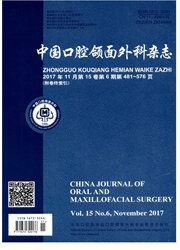

 中文摘要:
中文摘要:
目的:内镜辅助下或依靠机器人经耳后径路或其改良径路行早期口腔癌(c T1-2N0)的择区性颈淋巴清扫术(selective neck dissection,SND)已有报道,然而,此种术式所带来的美观效果是以较大的手术创伤为代价。本文探讨内镜辅助下经下颌下径路行早期口腔癌(c T1-2N0)SND的手术创伤和美观效果。方法:54例早期口腔癌患者(c T1-2N0)随机分为内镜组和开放组2组。对患者围术期和术后相关指标进行评估,包括颈清扫切口长度、颈清扫时间、术中出血量;术后引流量和引流时间、总住院时间、清扫淋巴结数目、患者美观满意度、围术期并发症、肩部功能和随访情况。结果:内镜组平均手术时间为(124.04±13.47)min,较开放组(73.47±15.36)min长。但内镜组平均切口长度仅为(4.23±0.56)cm,同时术后引流量和引流时间、总住院天数、术后肩部疼痛程度和美观效果均较开放组为优,而且2组清扫的淋巴结数目无显著差别。结论:内镜辅助下经下颌下径路行SND的时间较开放组长,但手术创伤小,美观效果好。
 英文摘要:
英文摘要:
PURPOSE: Selective neck dissection(SND) in clinical N0(c N0) cases of oral squamous cell carcinoma has been performed by surgeons using a retroauricular or modified facelift approach with robotic or endoscopic assistance.However, these procedures provide cosmetic satisfaction at the cost of possible maximal invasiveness. In this prospective study, we introduced and evaluated the feasibility as well as surgical invasiveness and cosmetic outcome of endoscopically assisted SND via a small submandibular approach. METHODS: Fifty-four patients with c T1-2N0 oral squamous cell carcinoma(OSCC) were randomly divided into 2 groups of endoscopically assisted SND and conventional SND.Perioperative and postoperative outcomes of the patients were evaluated, including the length of the incision, operating time for neck dissection, estimated blood loss during the operation, amount and duration of drainage, total hospitalization period, total number of lymph nodes retrieved, satisfaction scores based on the cosmetic results, perioperative local complications, shoulder syndrome and follow-up information. RESULTS: The mean operation time in the endoscopically assisted group(124.04±13.47 min) was longer than that in the conventional group(73.47±15.36 min). However, the mean length of the incision was(4.23 ±0.56) cm in the endoscopically assisted SND group, and the amount and duration of drainage, total hospital stay, postoperative shoulder pain score and cosmetic outcomes were superior in the endoscopically assisted SND group. Additionally, the retrieved lymph nodes and complications were comparable. CONCLUSIONS:Endoscopically assisted SND via a small submandibular approach had a longer operation time than the conventional approach. However, endoscopically assisted SND was feasible and reliable which provided minimal invasiveness and satisfactory appearance.
 同期刊论文项目
同期刊论文项目
 同项目期刊论文
同项目期刊论文
 期刊信息
期刊信息
